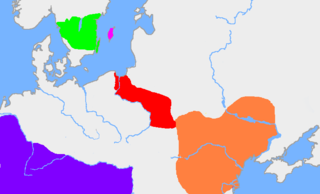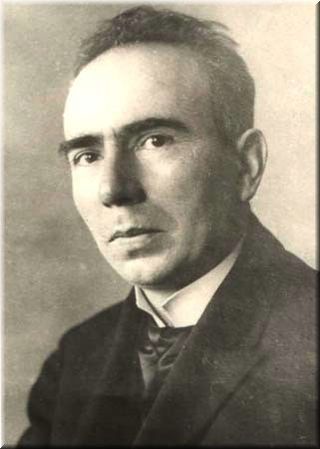
Jordanes, also written as Jordanis or Jornandes, was a 6th-century Eastern Roman bureaucrat, widely believed to be of Gothic descent, who became a historian later in life.
Zalmoxis also known as Salmoxis (Σάλμοξις), Zalmoxes (Ζάλμοξες), Zamolxis (Ζάμολξις), Samolxis (Σάμολξις), Zamolxes (Ζάμολξες), or Zamolxe (Ζάμολξε) is a divinity of the Getae and Dacians, mentioned by Herodotus in his Histories Book IV, 93–96, written before 425 BC.

The Dacians were the ancient Indo-European inhabitants of the cultural region of Dacia, located in the area near the Carpathian Mountains and west of the Black Sea. They are often considered a subgroup of the Thracians. This area includes mainly the present-day countries of Romania and Moldova, as well as parts of Ukraine, Eastern Serbia, Northern Bulgaria, Slovakia, Hungary and Southern Poland. The Dacians and the related Getae spoke the Dacian language, which has a debated relationship with the neighbouring Thracian language and may be a subgroup of it. Dacians were somewhat culturally influenced by the neighbouring Scythians and by the Celtic invaders of the 4th century BC.

De origine actibusque Getarum, commonly abbreviated Getica, written in Late Latin by Jordanes in or shortly after 551 AD, claims to be a summary of a voluminous account by Cassiodorus of the origin and history of the Gothic people, which is now lost. However, the extent to which Jordanes actually used the work of Cassiodorus is unknown. It is significant as the only remaining contemporaneous resource that gives an extended account of the origin and history of the Goths, although to what extent it should be considered history or origin mythology is a matter of dispute.

The Getae or Gets were a Thracian-related tribe that once inhabited the regions to either side of the Lower Danube, in what is today northern Bulgaria and southern Romania. Although it is believed that the Getae were related to their westward neighbours, the Dacians, several scholars, especially in the Romanian historiography, posit that the Getae and the Dacians were the same people.
Dromichaetes was king of the Getae on both sides of the lower Danube around 300 BC.

Oium was a name for Scythia, or a fertile part of it, roughly in modern Ukraine, where the Goths, under a legendary King Filimer, settled after leaving Gothiscandza, according to the Getica by Jordanes, written around 551.
Deceneus or Decaeneus was a priest of Dacia during the reign of Burebista. He is mentioned in the near-contemporary Greek Geographica of Strabo and in the 6th-century Latin Getica of Jordanes, where he is called Dicineus.

Vasile Pârvan was a Romanian historian and archaeologist.
The Gutones were a Germanic people who were reported by Roman era writers in the 1st and 2nd centuries to have lived in what is now Poland. The most accurate description of their location, by the geographer Ptolemy, placed them east of the Vistula river.

Sântana de Mureș is a commune in Mureș County, Transylvania, Romania, composed of four villages:
The belagines were written laws which, according to Jordanes, were given to the Goths by Dicineus / Dekaineos, the Dacian-Getic legislator, Zalmoxian priest at the time of Burebista.
Criton of Heraclea was a 2nd-century Greek chief physician and procurator of Roman Emperor Trajan (98–117) in the campaign in Dacia. He is perhaps the Criton mentioned in Martial's Epigrams.
Dacica is a Latin work by Roman Emperor Trajan, written in the spirit of Julius Caesar's commentaries like De Bello Gallico, and describing Trajan's campaigns in Dacia.
Dacia: An Outline of the Early Civilization of the Carpatho-Danubian Countries is a history book by the Romanian historian and archaeologist Vasile Pârvan. The book, published post-mortem in 1928, resulted from a series of lectures that Pârvan gave at Cambridge University. Similar to his major work, Getica (1926), Dacia covers the ancient history of Carpatho-Danubian region. In both books, Pârvan presented Dacia as a great kingdom with a homogeneous ethnic base, an advanced civilization, and a well-defined political and national identity.
Getica was a historical book about the Getae tribes of Thrace which Suidas, Jordanes, and Freculphus attribute to Cassius Dio, while Philostratus sees Dio Chrysostom as its author. No copies of the book are known to exist.
Arne Søby Christensen is a Danish historian. He is an associate professor in history at the University of Copenhagen.
There were several origin stories of the Gothic peoples recorded by Latin and Greek authors in late antiquity, and these are relevant not only to the study of literature, but also by historians seeking evidence of real historical events involving the Goths and other peoples mentioned in these stories.
The history of Dacia comprises the events surrounding the historical region roughly corresponding to the present territory of Romania and Moldova and inhabited by the Getae and Dacian peoples, with its capital Sarmizegetusa Regia.






